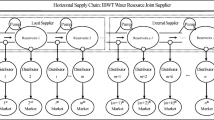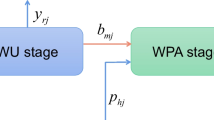Abstract
Faced with the rapid development of modern industries of agriculture, manufacturing, and services, water resources are becoming increasingly scarce. Industries with high water consumption are generally regulated by the government’s water cap-and-trade (CAT) regulation to solve the contradiction between the limited water supply and the rapid growing water demand. Supply chain equilibrium and coordination models under the benchmark scenario without water saving and CAT regulation, water-saving supply chain equilibrium and coordination models under the scenario without/with CAT regulation are developed, analyzed and compared. The corresponding numerical and sensitivity analyses for all models are conducted and compared, and the managerial insights and policy recommendations are summarized in this article. The results indicate that (1) Conducting water saving could improve effectively the operational performance of the water-saving supply chain under the scenario without/with CAT regulation. (2) The coordination strategy based on the revenue sharing contract could efficiently coordinate the water-saving supply chain, enhance water consumption reduction rate, and improve the operational performance of the water-saving supply chain. (3) The implementation of CAT regulation enhances effectively water-consumption-reduction in the water-saving supply chain and improves the operational performance of water-saving supply chain. (4) Simultaneous implementation of CAT regulation by the government and adopting coordination strategy by the water-saving supply chain would be superior to any other scenarios/strategies. (5) A suitable water cap based on the industrial average water consumption and historical water consumption data are beneficial for constructing reasonable and effective incentive mechanism. (6) A higher marginal trade price could induce more reduction in water consumption and create better operational performance for the manufacturer and water-saving supply chain, both under the equilibrium and coordination strategies.
Similar content being viewed by others
References
Campisano A, D’Amico G, Modica C (2017). Water saving and cost analysis of large-scale implementation of domestic rain water harvesting in minor Mediterranean Islands. Water (Basel), 9(12): 1–14
Gao H, Wei T, Lou I, Yang Z, Shen Z, Li Y (2014). Water saving effect on integrated water resource management. Resources, Conservation and Recycling, 93: 50–58
Gilg A, Barr S (2006). Behavioural attitudes towards water saving? Evidence from a study of environmental actions. Ecological Economics, 57(3): 400–414
Hu Y, Moiwo J P, Yang Y, Han S, Yang Y (2010). Agricultural watersaving and sustainable groundwater management in Shijiazhuang Irrigation District, North China Plain. Journal of Hydrology (Amsterdam), 393(3–4): 219–232
Ji J, Zhang Z, Yang L (2017). Comparisons of initial carbon allowance allocation rules in an O2O retail supply chain with the cap-and-trade regulation. International Journal of Production Economics, 187: 68–84
Khatib J M (2015). Energy, Environmental & Sustainable Ecosystem Development: International Conference on Energy, Environmental & Sustainable Ecosystem Development (EESED 2015). Singapore: World Scientific
Liu H, Guo J, He W (2014). The research on subject behavioral risk of whole life-cycle water conservation projects. Frontiers of Engineering Management, 1(4): 348–352
Lu Y, Shang C (2014). The environmental impact of the three gorges project and the countermeasures. Frontiers of Engineering Management, 1(2): 120–128
Luckmann J, Grethe H, McDonald S (2016). When water saving limits recycling: Modelling economy-wide linkages of wastewater use. Water Research, 88: 972–980
Monaco F, Sali G, Hassen M B, Facchi A, Romani M, Valè G (2016). Water management options for rice cultivation in a temperate area: A multi-objective model to explore economic and water saving results. Water (Basel), 8(8): 1–21
Nikouei A, Zibaei M, Ward F A (2012). Incentives to adopt irrigation water saving measures for wetlands preservation: An integrated basin scale analysis. Journal of Hydrology (Amsterdam), 464–465: 216–232
Novak J, Melenhorst M, Micheel I, Pasini C, Fraternali P, Rizzoli A E (2018). Integrating behavioural change and gamified incentive modelling for stimulating water saving. Environmental Modelling & Software, 102: 120–137
Ørum J E, Boesen M V, Jovanovic Z, Pedersen S M (2010). Farmers’ incentives to save water with new irrigation systems and water taxation–A case study of Serbian potato production. Agricultural Water Management, 98(3): 465–471
Peterson J M, Ding Y (2005). Economic adjustments to groundwater depletion in the high plains: Do water-saving irrigation systems save water? American Journal of Agricultural Economics, 87(1): 147–159
Shang H, Zhou S, Zhang L (2008). Circular Economy Development Evaluation and Policy Design. Beijing: China Financial & Economic Publishing House
Varouchakis E A, Apostolakis A, Siaka M, Vasilopoulos K, Tasiopoulos A (2018). Alternatives for domestic water tariff policy in the municipality of Chania, Greece, toward water saving using game theory. Water Policy, 20(1): 175–188
WWAP (United Nations World Water Assessment Programme) (2015). The United Nations World Water Development Report 2015: Water for a Sustainable World. Paris: UNESCO (United Nations Educational, Scientific and Cultural Organization)
Xie G (2015). Modelling decision processes of a green supply chain with regulation on energy saving level. Computers & Operations Research, 54: 266–273
Xin B, Sun M (2018). A differential oligopoly game for optimal production planning and water savings. European Journal of Operational Research, 269(1): 206–217
Xu X, He P, Hao X, Zhang Q (2017). Supply chain coordination with green technology under cap-and-trade regulation. International Journal of Production Economics, 183: 433–442
Xu X, Zhang W, He P, Xu X (2017). Production and pricing problems in make-to-order supply chain with cap-and-trade regulation. Omega, 66: 248–257
Yi Y, Li J (2018). Cost-Sharing contracts for energy saving and emissions reduction of a supply chain under the conditions of government subsidies and a carbon tax. Sustainability, 10(3): 895
Zhang D, Guo P (2016). Integrated agriculture water management optimization model for water saving potential analysis. Agricultural Water Management, 170: 5–19
Zhou L, Xu K, Cheng X, Xu Y, Jia Q (2017). Study on optimizing production scheduling for water-saving in textile dyeing industry. Journal of Cleaner Production, 141: 721–727
Author information
Authors and Affiliations
Corresponding author
Additional information
This work is supported by the National Natural Science Foundation of China (Grant Nos. 71603125, 71433003, 91646122, 91746202), China Scholarship Council (Grant No. 201706865020), the National Key R&D Program of China (2017YFC0404600), the Natural Science Research Project of Colleges and Universities in Jiangsu Province (15KJB110012), the Philosophy and Social Science Research Project of Colleges and Universities in Jiangsu Province (2014SJB094), the Humanities and Social Sciences Young Scientist Project of Nanjing Normal University (1409006), the Project funded by China Postdoctoral Science Foundation (2014M551623), the Jiangsu Planned Projects for Postdoctoral Research Funds (1301077C), and the Humanity and Social Science Youth foundation of China Ministry of Education (17YJC790002).
Rights and permissions
About this article
Cite this article
Chen, Z., Fang, L. & Wang, H. Internal incentives and operations strategies for the water-saving supply chain with cap-and-trade regulation. Front. Eng. Manag. 6, 87–101 (2019). https://doi.org/10.1007/s42524-019-0006-7
Received:
Accepted:
Published:
Issue Date:
DOI: https://doi.org/10.1007/s42524-019-0006-7




